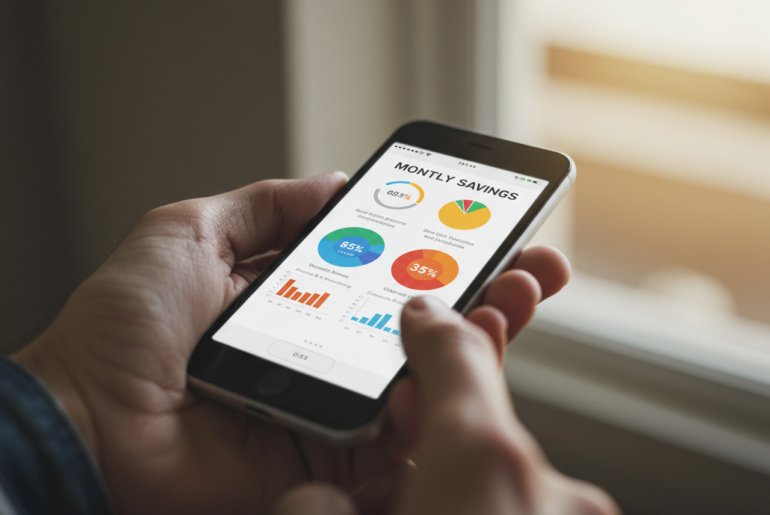This article may contain references to products or services from one or more of our advertisers or partners. We may receive compensation when you click on links to those products or services. Nonetheless, our opinions are our own.
- Understanding Your Monthly Budget Breakdown
- Essential Categories You Shouldn’t Overlook
- Common Pitfalls That Can Inflate Your Expenses
- Ways to Save Money Without Changing Your Lifestyle
- How to Use Technology for Better Expense Tracking
- Creating a Flexible Budget That Works for You
- Conclusion
- Frequently Asked Questions
- Recommended Reads
Understanding Your Monthly Budget Breakdown
Breaking down your monthly budget can feel overwhelming at first. However, understanding where your money goes is the first step toward taking control of your finances. Your expenses can be divided into three main categories: necessities, savings, and personal spending. By analyzing these areas, you can identify opportunities to adjust your habits and enhance your financial well-being.
Necessities
This includes your rent or mortgage, utility bills, food, and travel costs. These are must-haves—make sure to prioritize them in your budget.
Savings
Aim to save at least 20% of your income. This money can be allocated to an emergency fund, retirement accounts, or future goals, such as buying a home or funding education.
Discretionary Spending
These are your fun expenses—dining out, entertainment, and hobbies. While it’s important to enjoy life, be sure to keep these costs within a reasonable portion of your budget.
Expense Category
| Category | Percentage of Monthly Income |
|---|---|
| Necessities | 50% |
| Savings | 20% |
| Discretionary Spending | 30% |
Keep track of your spending for a month to see how it compares to these benchmarks. This will help you make more informed financial decisions and align your money habits with your goals.
Essential Categories You Shouldn’t Overlook
When managing your monthly expenses, it’s easy to forget certain cost categories. However, they’re essential for a stable financial life. Here are some key areas that often slip through the cracks:
Emergency Fund
This is your safety net for unexpected expenses, such as car repairs, medical bills, or job loss. Try to save enough to cover three to six months of living expenses.
Health Insurance
Healthcare costs can rise quickly. Even with employer-provided insurance, it’s wise to budget for copays, deductibles, and out-of-pocket expenses.
Subscription Services
From streaming platforms to gym memberships, these recurring costs can quietly drain your budget. Regularly review them and cancel any that you don’t use.
Debt Repayment
Allocate part of your income to pay off debts, such as credit cards, student loans, or personal loans. Reducing debt improves your financial stability and credit score.
Here’s a Sample Budget Breakdown:
| Expense Category | Percentage of Monthly Income |
|---|---|
| Housing | 30% |
| Utilities | 5% |
| Groceries | 15% |
| Transportation | 10% |
| Insurance | 10% |
| Discretionary Spending | 15% |
| Savings & Investments | 5% |
By addressing these often-overlooked areas, your budget will be better equipped to handle both your present needs and future goals.
Common Pitfalls That Can Inflate Your Expenses
Tracking your expenses is crucial—but even the most mindful budgeters can fall into these common traps:
Impulse Purchases
Buying small items without planning might not seem like a significant issue, but they can add up. Regularly reviewing your spending can help spot and curb this habit.
Subscription Services
It’s easy to forget about all the services you’ve signed up for. Conduct regular audits and cancel subscriptions that no longer provide value.
Dining Out
Meals out are enjoyable but costly. Cooking at home more often can significantly lower your food expenses and potentially improve your nutrition.
Overlooking Annual Fees
Hidden fees from bank accounts, credit cards, or memberships can sneak up on you. Review your statements and consider switching to no-fee options where possible.
Expense Type
| Type | Average Monthly Cost |
|---|---|
| Dining Out | $250 |
| Subscriptions | $100 |
| Impulse Purchases | $150 |
By avoiding these pitfalls, you can strengthen your budget and align your spending with your financial goals.
Ways to Save Money Without Changing Your Lifestyle
Saving money doesn’t have to mean cutting out everything you enjoy. Start by trimming areas that don’t affect your quality of life:
Review Subscriptions
Consolidate or cancel services you barely use. A few forgotten subscriptions can easily cost you hundreds each year.
Meal Planning
Planning your meals and shopping with a list can reduce impulse grocery purchases and food waste. It also helps you stick to healthier and cheaper meals at home.
Meal Planning Impact
| Category | Before | After |
|---|---|---|
| Weekly Grocery Total | $150 | $100 |
| Food Wasted | $30 | $10 |
| Meals Prepared at Home | 3 | 5 |
Compare Insurance Rates
Insurance premiums vary. Comparing quotes online could lead to better coverage at lower prices.
Use Public Transport or Ridesharing
Reducing the number of car trips can lower gas, parking, and maintenance costs.
Smart spending habits can help you save without giving up comfort or enjoyment.
How to Use Technology for Better Expense Tracking
Tech tools can make managing your money easier and more accurate.
Budgeting Apps
Apps like Mint, You Need a Budget (YNAB), and PocketGuard connect to your accounts and automatically sort expenses. They help you set limits, track goals, and identify spending trends.
Spreadsheets
If you prefer a hands-on approach, create a custom budget spreadsheet. This allows for personalized categories and full control.
Sample Spreadsheet Format
| Category | Amount Spent |
|---|---|
| Housing | $1,500 |
| Utilities | $250 |
| Groceries | $400 |
| Transportation | $200 |
Digital Receipts
Use your bank or app’s receipt scanning feature to keep a digital record of purchases. It simplifies tracking and reduces the likelihood of lost receipts.
Consistently using technology can streamline your budgeting and give you more confidence in your financial decisions.
Creating a Flexible Budget That Works for You
A good budget isn’t rigid—it grows with your life.
Understand Your Costs
Separate your fixed costs (like rent and insurance) from your variable ones (like food and entertainment). This helps you adjust more easily when your income or expenses change.
Track Spending vs. Estimates
Keep a simple monthly chart that compares your estimated spending with your actual spending.
| Expense Category | Monthly Estimate | Actual Spending |
|---|---|---|
| Housing | $1,500 | |
| Utilities | $200 | |
| Groceries | $300 | |
| Transportation | $150 | |
| Entertainment | $100 | |
| Savings | $300 |
When you review your numbers, look for areas where you consistently over- or under-spend. This helps you refine your budget and prepare for future changes.
Calculate Your Income
Start with your total monthly income after taxes to set realistic limits for each category.
List All Expenses
Create a full list of your fixed and variable costs. This ensures you don’t overlook anything when building your plan.
A flexible budget lets you make better choices without feeling restricted—helping you stay in control as your life evolves.
Conclusion
Managing your monthly spending effectively is crucial to achieving long-term financial stability. By understanding where your money goes, covering the essential categories, avoiding common pitfalls, and adopting smart cost-saving habits, you can create a budget that works without compromising your lifestyle. Utilize technology, remain flexible, and review your plan regularly to ensure it evolves with you.
With thoughtful planning and daily awareness, you can create a financial future built on purpose, not pressure.
Frequently Asked Questions
What are the three main categories to include in my monthly budget?
The three main categories are necessities, savings, and discretionary spending. Necessities include rent, utilities, food, and transportation. Savings should be at least 20% of your income, and discretionary expenditures covers entertainment, dining out, and hobbies.
How can I reduce my expenses without sacrificing my lifestyle?
You can trim expenses by reviewing subscriptions you no longer use, planning your meals to reduce grocery costs, comparing insurance rates for better deals, and using public transport or ridesharing to lower transportation expenses.
What are some common pitfalls that can inflate my monthly expenses?
Common pitfalls include impulse purchases, forgotten subscription services, frequent dining out, and overlooking annual fees. Regularly tracking and reviewing these areas can help you avoid unnecessary spending.
How can technology help me manage my budget more effectively?
Budgeting apps like Mint and YNAB can automatically track your expenses, while spreadsheets give you full control over your budget. Additionally, using digital receipts helps you keep track of purchases easily and stay organized.

Reviewed and edited by Albert Fang.
See a typo or want to suggest an edit/revision to the content? Use the comment form below for feedback.
At FangWallet, we value editorial integrity and open collaboration in curating quality content for readers to enjoy. Much appreciated for the assist.
Did you like our article and find it insightful? We encourage sharing the article link with family and friends to benefit as well - better yet, sharing on social media. Thank you for the support! 🍉
Article Title: Break Down Your Budget and Save More Every Month
https://fangwallet.com/2025/04/25/save-more-every-month/The FangWallet Promise
FangWallet is an editorially independent resource - founded on breaking down challenging financial concepts for anyone to understand since 2014. While we adhere to editorial integrity, note that this post may contain references to products from our partners.
The FangWallet promise is always to have your best interest in mind and be transparent and honest about the financial picture.
Become an Insider
Editorial Disclaimer: The editorial content on this page is not provided by any of the companies mentioned. The opinions expressed here are the author's alone.
The content of this website is for informational purposes only and does not represent investment advice, or an offer or solicitation to buy or sell any security, investment, or product. Investors are encouraged to do their own due diligence, and, if necessary, consult professional advising before making any investment decisions. Investing involves a high degree of risk, and financial losses may occur including the potential loss of principal.
Source Citation References:
+ Inspo
There are no additional citations or references to note for this article at this time.










































